
In the botanical classification of plants, Aeridinae Pfitzer is a subtribe of the tribe Vandeae whose representatives all have a monopodial growth habit and do not possess pseudobulbs.

Stanhopea is a genus of the orchid family (Orchidaceae) from Central and South America. The abbreviation used in horticultural trade is Stan. The genus is named for the 4th Earl of Stanhope (1781-1855), president of the Medico-Botanical Society of London (1829-1837). It comprises 55 species and 5 natural hybrids. These epiphytic, but occasionally terrestrial orchids can be found in damp forests from Mexico to Trinidad to NW Argentina. Their ovate pseudobulbs carry from the top one long, plicate, elliptic leaf.

The taxonomy of the Orchidaceae (orchid family) has evolved slowly during the last 250 years, starting with Carl Linnaeus who in 1753 recognized eight genera. De Jussieu recognized the Orchidaceae as a separate family in his Genera Plantarum in 1789. Olof Swartz recognized 25 genera in 1800. Louis Claude Richard provided us in 1817 with the descriptive terminology of the orchids. (See External links below). The next step was taken in 1830-1840 by John Lindley, who recognized four subfamilies. He is generally recognized as the father of orchid taxonomy. The next important step was taken by George Bentham with a new classification, recognizing subtribes for the first time. This classification was first presented in a paper that Bentham read to the Royal Society in 1881. Then it was published in 1883 in the final volume of Genera Plantarum. The next great contributors were Pfitzer (1887), Schlechter (1926), Mansfeld (1937), Dressler and Dodson (1960), Garay (1960, 1972), Vermeulen (1966), again Dressler (1981). and Burns-Balogh and Funk (1986). Dressler's 1993 book had considerable influence on later work.

Selenipedium is a genus of the orchid family (Orchidaceae). The genus has been given its own tribe, Selenipedieae, and subtribe, Selenipediinae. It is abbreviated Sel in trade journals.
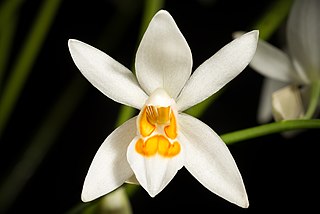
Arethuseae is a mid-sized tribe of orchids in the subfamily Epidendroideae. This tribe was initially categorized by John Lindley in 1840. Its largest subtribes are Arethusinae and Coelogyninae.

Satyrium is a genus of orchid. The Kew plant list for 2010 listed 85 full species as accepted, ignoring synonyms, subspecies and hybrids etc. About ten were still unresolved at the time. Most of the species occur in sub-Saharan Africa and Madagascar. The ranges of four species extend to Asia, mainly in India and Sri Lanka. Hybridization occurs between several species, complicating molecular phylogenetic studies, especially those relying on mitochondrial and chloroplast DNA sequences.
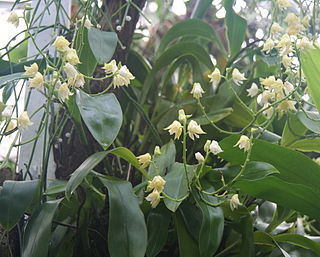
Polystachya, abbreviated Pol in horticultural trade, and commonly known as yellowspike orchid, is a flowering plant genus in the orchid family (Orchidaceae). This rather distinctive genus was described by William Jackson Hooker in 1824 and is the type genus of the subtribe Polystachyinae. It contains about 100 species widespread across many of the tropical areas of the world.
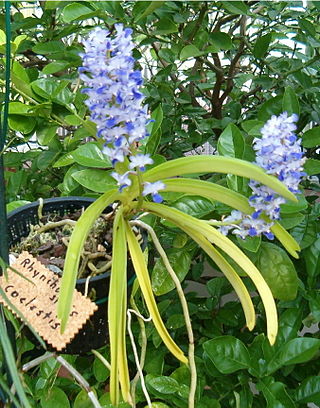
Rhynchostylis is a genus in the orchid family (Orchidaceae), closely allied to the genus Vanda and comprising four currently accepted species native to the Indian Subcontinent, China, Indochina, Malaysia, Indonesia and the Philippines. The name consists of a compound of two Greek elements : rhynchos 'beak' and stylis 'column' – in reference to the very broad, fleshy column of the flower. The flowers are borne in dense racemes and are noted for their intense, spicy fragrance. Although lacking in pseudobulbs, the plants have leathery leaves that are drought-resistant. These orchids grow naturally in warm, moist, shaded tropical areas and will thrive in cultivation if given consistent warmth, uniform moisture and bright, but indirect light. Hobbyists wanting to grow them will need a warm, humid growing environment with gentle air movement. They can be grown in pots, but are better grown in baskets, owing to the extreme fleshiness of their roots. Their unusually fragrant blooms often appear in the slightly cooler winter months.
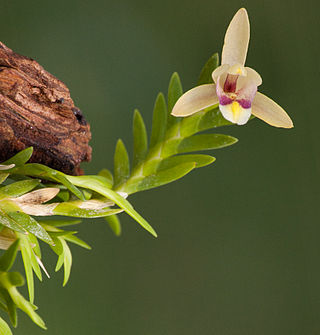
The Vandeae is a large monophyletic tribe within the family of orchids.
Hanna Bogna Margońska, born 1968 is a Polish botanist known for her work on orchids.

Eltroplectris, the long-claw orchid, is a genus of flowering plants from the orchid family, Orchidaceae. It is native to South America, the West Indies, and Florida.
- Eltroplectris assumpcaoanaCampacci & Kautsky - Brazil
- Eltroplectris brachycentronSzlach. -Bolivia
- Eltroplectris calcarata(Sw.) Garay & H.R.Sweet - Florida, Bahamas, Cayman Islands, Cuba, Hispaniola, Jamaica, Puerto Rico, Windward Islands, Trinidad, Suriname, Venezuela, Colombia, Peru, Brazil, Paraguay
- Eltroplectris cogniauxiana(Schltr.) Pabst - Brazil
- Eltroplectris dalessandroiDodson - Ecuador
- Eltroplectris janeirensis(Porto & Brade) Pabst - Brazil
- Eltroplectris kuhlmanniana(Hoehne) Szlach. & Rutk. in P.Rutkowski, D.L.Szlachetko & M.Górniak - Brazil
- Eltroplectris longicornu(Cogn.) Pabst - Brazil
- Eltroplectris macrophylla(Schltr.) Pabst - Brazil
- Eltroplectris misera(Kraenzl.) Szlach. - Brazil
- Eltroplectris rossiiDodson & G.A.Romero - Ecuador
- Eltroplectris schlechteriana(Porto & Brade) Pabst - Brazil, Argentina, Paraguay
- Eltroplectris triloba(Lindl.) Pabst - Brazil, Argentina, Paraguay

Fernandezia is a genus of flowering plants from the orchid family, Orchidaceae. It contains about 30-40 species, native to northern South America, Central America, and southern Mexico.
Galeottiella is a genus of flowering plants from the orchid family, Orchidaceae. Traditionally it had been included in subtribe Spiranthinae, but following molecular phylogenetic and morphological studies it is now placed in a subtribe on its own, Galeottiellinae.
Risleya is a monotypic genus of flowering plants from the orchid family, Orchidaceae. The sole species is Risleya atropurpurea. It is native to the Himalayas of Sichuan, Tibet, Yunnan, Bhutan, India, Sikkim, Assam and Myanmar. It was previously included in the subtribe Malaxidinae but is now placed in the tribe Collabieae.

Angraecinae is a subtribe in the family Orchidaceae. The subtribe consists of approximately 47 genera. The type genus is Angraecum. Most of the genera are endemic to Africa, Madagascar and other Indian Ocean Islands, a few genera can also be found in the Americas.

The Eriinae form a subtribe of Podochileae, a tribe of the orchid family (Orchidaceae). The name is derived from the genus Eria.

Dendrobieae is a tribe in the subfamily Epidendroideae, in the family Orchidaceae. The Dendrobieae are mostly tropical, epiphytic orchids which contain pseudobulbs.
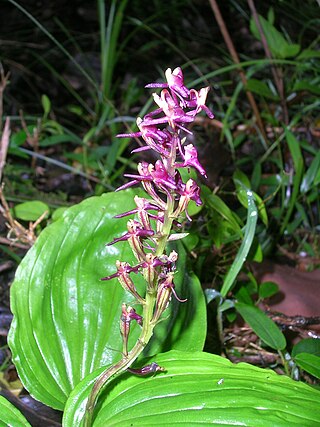
Malaxidinae is an subtribe of orchids in the tribe Malaxideae of the subfamily Epidendroideae.

Maxillariinae is an orchid subtribe in the tribe Cymbidieae. It was formerly treated as the tribe Maxillarieae, and divided into a number of subtribes.
















